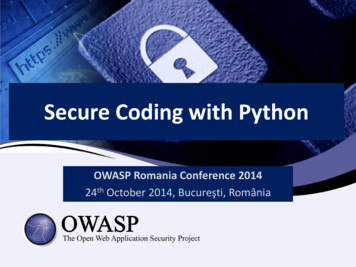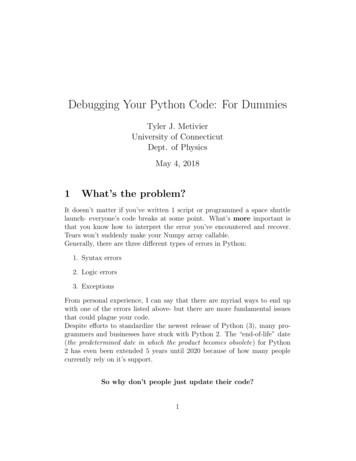
Transcription
Secure Coding with PythonOWASP Romania Conference 201424th October 2014, Bucureşti, România
About MeStarted to work in IT in 1997, moved to information security in 2001. Workingin information security for over a decade with experience in software security,information security management, and information security R&D.Worked in many roles like Senior Security Engineer, Security Architect,Disaster Recovery Specialist, Microsoft Security Specialist, etc etc.Leader of “OWASP Python Security” Project http://www.pythonsecurity.org/Co-Leader of “OWASP Project Metrics” Project https://github.com/OWASP/OWASP-Project-Metrics24th October 2014, Bucureşti, România2
OWASP Python Security ProjectA new ambitious project that aims at making python moresecure and viable for usage in sensitive environments. We have started a full security review of python by checkingcore modules written in both C and python First goal is to have a secure layer of modules for LINUXThe security review takes a lot of time and we are slowlypublishing libraries and tools, documentation will follow 24th October 2014, Bucureşti, România3
OWASP Python Security ProjectPython Security is a free, open source, OWASP Project that aims atcreating a hardened version of python that makes it easier forsecurity professionals and developers to write applications moreresilient to attacks and manipulations.Our code in GITHUB: https://github.com/ebranca/owasp-pysec/Known Issues in python modules concerning software security: ty-Concernsin-modules-and-functions24th October 2014, Bucureşti, România4
Total Software Flaws (CVE)01/2001 to 12/2013After checking statistics generated fromvendors we have to also check datagenerated by the community at large.7,0006,000Statistics on publicly disclosed vulnerabilitiesare available at the site “NIST.gov” under thename “National Vulnerability vuln/statistics3,0002,0001,00002001 2002 2003 2004 2005 2006 2007 2008 2009 2010 2011 2012 2013Series1We will review vulnerability stats:- By Access vector- By Complexity- By Severity- By CategoryThen we will formulate some istics24th October 2014, Bucureşti, România5
Number of Software Flaws (CVE)by Access VectorTrend of Software Flaws (CVE)By Access atistics24th October 2014, Bucureşti, România6
Number of Software Flaws (CVE)by ComplexityTrend of Software Flaws (CVE)by ttp://web.nvd.nist.gov/view/vuln/statistics24th October 2014, Bucureşti, România7
Initial review of “National Vulnerability Database”statistics revealed:– Number of public vulnerabilities relaying on “network” isdecreasing– Number of public vulnerabilities relaying on “localnetwork” access (adjacent networks) in increasing– Number of public vulnerabilities relaying on “local accessonly” access in increasing– Medium or low complexity Vulnerabilities are preferred24th October 2014, Bucureşti, România8
Analysis of the “Web Application VulnerabilityStatistics 2013” report revealed:– Rate of server misconfigurations is increasing– Authentication issues are increasingly not checked– Authorization issues are increasingly not checked– Server application headers are not sanitized– Server application error are not filtered– Server default files/dirs are left accessible24th October 2014, Bucureşti, România9
How network configurations can impact internalcode operations? IP Fragmentation– https://isc.sans.edu/forums/diary/IP Fragmentation Attacks/13282– http://www.snort.org/assets/165/target based frag.pdf– f Depending on the system reading the fragmented packetsarriving at the NIC, the reassembly process can either DESTROYor REASSEMBLE the original stream, as an application may havesent valid data but the receiving end may see only random data.24th October 2014, Bucureşti, România10
def genjudyfrags():pkts scapy.plist.PacketList()pkts.append(IP(flags "MF",frag 0)/("1"*24))pkts.append(IP(flags "MF",frag 4)/("2"*16))pkts.append(IP(flags "MF",frag 6)/("3"*24))pkts.append(IP(flags "MF",frag 1)/("4"*32))pkts.append(IP(flags "MF",frag 6)/("5"*24))pkts.append(IP(frag 9)/("6"*24))return pktsThis section of code will generatesix packet fragments as outlined in“IP Fragment Reassembly withscapy“ with the offsets specified inthe Shankar/Paxson and Novakpapers.The picture is taken fromthe Novak paper andrepresent the final packetorder per each arget based frag.pdf24th October 2014, Bucureşti, România11
python -OOBR reassembler.py –demoReassembled using policy: First (Windows, SUN, MacOS, 6Reassembled using policy: Last/RFC791 666Reassembled using policy: Linux (Umm. 66Reassembled using policy: BSD (AIX, FreeBSD, HPUX, Reassembled using policy: BSD-Right (HP Jet 66624th October 2014, Bucureşti, România12
What about numeric operations?As an example we will take in consideration LINUX.Many security operations are based on random numbers andevery linux system using any cryptographic function can beimpacted by the lack of good entropy.What is generally overlooked is that under linux almost everyprocess uses entropy when is created and even the networkstack uses entropy to generate the “TCP-syn cookies”.24th October 2014, Bucureşti, România13
This is an expected behavior and is working as designed. Spawning a process uses (on average) 16 bytes of entropy per“exec()”, therefore when server load spikes entropy is quicklydepleted as the kernel is not generating entropy fast enough. Also when a system is built to use “Stack Smashing Protector”(SSP) by default it uses “/dev/urandom” directly, this tends toconsume all the kernel entropy. Almost all modern Linux systems use “Address space layoutrandomization“ (ASLR) and stack protections that need a smallamount of entropy per process. Since “/dev/urandom” alwaysremixes, it doesn't strictly run out, but the entropy drops.24th October 2014, Bucureşti, România14
In fact many linux command used to check the amount ofentropy are “consuming” it and may lead to it’s depletion. For example this command will “consume” entropy– watch cat /proc/sys/kernel/random/entropy avail But this python one-line script will NOT use entropy:– python -c " (echo -e "import time\nwhile True:\n time.sleep(0.5)\nprint open('/proc/sys/kernel/random/entropy avail', 'rb').read(),")" Also the command “inotifywatch -v -t 60 /dev/random” willmonitor the access to “/dev/random” without using entropy24th October 2014, Bucureşti, România15
What happens to the entropy level in aworking linux server under average load?250150-200 bits Entropy lowest limit200150Generate1024bits SSL keyGenerate128bits SSL 018178338498658818979139295024th October 2014, Bucureşti, România16
Under linux every process uses entropy and every server“should” not have less than 200 bits. It Is possible toincrease the entropy level using entropy deamons like thepackage “haveged”. (http://www.issihosts.com/haveged/)45004000Haveged RunningHaveged Running350030002500200015001000Haveged 09024th October 2014, Bucureşti, România17
PYTHON for tbags py-pcapflowgrepMalloryPytbull0trace PYTHON for fuzzing?SulleyPeach boxWSBangConstructFusilSMUDGE24th October 2014, Bucureşti, România18
OWASP Secure Coding Principles1. Minimize attack surface area2. Establish secure defaults3. Principle of Least privilege4. Principle of Defence in depth5. Fail securely6. Don’t trust services7. Separation of duties8. Avoid security by obscurity9. Keep security simple10. Fix security issues correctly24th October 2014, Bucureşti, România19
In reality “Secure coding” is a PRACTICEPractice: “the actual application or use of an idea,belief, or method, as opposed to theories relating to it”The definition of “secure coding” changes over time aseach person/company has different ideas. Is about how to DESIGN code to be inherentlysecure and NOT on how to write secure code24th October 2014, Bucureşti, România20
As a PRACTICE secure coding includes but isnot limited to: Definition of areas of interest Analysis of architectures involved Review of implementation details Verification of code logic and syntax Operational testing (unit testing, white-box) Functional testing (black-box)24th October 2014, Bucureşti, România21
Secure coding depends on “functional testing”– Functional testing: “verifies a program by checking itagainst . design document(s) or specification(s)”– System testing: “validate[s] a program by checking itagainst the published user or system requirements”(Kaner, Falk, Nguyen. Testing Computer Software. Wiley Computer Publishing, 1999) Operational testing white-box testing nal acceptance testing) Functional testing black-box testing–(http://en.wikipedia.org/wiki/Functional testing)24th October 2014, Bucureşti, România22
PYTHON use with moderationWe have seen some powerful tools written in python but whatabout the security of python itself? Are there operations to avoid? Any module or core library to use with caution? Something to know before writing code for security?24th October 2014, Bucureşti, România23
EXAMPLE – numeric overflowRESULT (debian 7 x64)Traceback (most recent call last):N 2 ** 63File "xrange overflow.py", line 5, in module for n in xrange(N):for n in xrange(N):print nOverflowError: Python int too large to convertto C longPROBLEM: xrange uses "Plain Integer Objects" created by the OSSOLUTION: Use python "long integer object“ that will allownumbers of arbitrary length as the limit will be the system'smemory.24th October 2014, Bucureşti, România24
EXAMPLE – operations with file descriptorsRESULTclose failed in file object destructor:sys.excepthook is missinglost sys.stderrimport sysimport iofd io.open(sys.stdout.fileno(), 'wb')fd.close()try:sys.stdout.write("test for error")except Exception:raiseCode is trying to write a non-zeroamount of data to something thatdoes not exists.The file descriptor has been closedand nothing can be sent, but pythonhas no control over it and returns asystem error.24th October 2014, Bucureşti, România25
EXAMPLE - File descriptors in WindowsC:\Python27 python.exe -VPython 2.7.6python.exe -OOBtt “winfd 1.py”import ioimport sysfd io.open(sys.stdout.fileno(), 'wb')fd.close()sys.stdout.write(“Now writing to stdout closed FD will cause a crash")24th October 2014, Bucureşti, România26
EXAMPLE – string evaluationimport sysimport ostry:eval(" import ('os').system('clear')", {})#eval(" import ('os').system(cls')", {})print "Module OS loaded by eval"except Exception as e:print repr(e)The function "eval" executes a string but is not possible to anycontrol to the operation. Malicious code is executed without limitsin the context of the user that loaded the interpreter.REALLY DANGEROUS24th October 2014, Bucureşti, România27
EXAMPLE – input evaluationSecret "A SECRET DATA"Public "a COCONUT"value input("Please enter your age ")print "There are",value,print "monkeys looking for",PublicWhat you type as input is interpretedthrough an expression and theresult is saved into your targetvariable with no control or limits.python -OOBRtt input 1.pyPlease enter your age 32There are 32 monkeys looking for a COCONUTThe dir() function returns “most”of the attributes of an object.python -OOBRtt input 1.pyPlease enter your age dir()There are ['Public', 'Secret', ' builtins ', ' doc ', ' file ', ' name ', ' package '] monkeyslooking for a COCONUTpython -OOBRtt input 1.pyPlease enter your age SecretThere are A SECRET DATA monkeys looking for a COCONUT24th October 2014, Bucureşti, România28
Unicode string encode/decodeRESULTCorrect-String "u'A\\ufffdBC\\ufffd'"CODECS-String "u'A\\ufffdBC'"IO-String "u'A\\ufffdBC\\ufffd'" KNOWN GOOD STRING WRONG OKThe problem is due to a bug in the "codec" library that detects the character"F4" and assumes this is the first character of a sequence of characters and waitto receive the remaining 3 bytes, and the resulting string is truncated.A better and safer approach would be to read the entire stream and only thenproceed to the decoding phase, as done by the ”io” module.24th October 2014, Bucureşti, România29
CODE – Unicode string encode/decodeimport codecsimport iotry:asciiexcept NameError:ascii reprb b'\x41\xF5\x42\x43\xF4'print("Correct-String %r") % ((ascii(b.decode('utf8', 'replace'))))with open('temp.bin', 'wb') as fout:fout.write(b)with codecs.open('temp.bin', encoding 'utf8', errors 'replace') as fin: ISSUE HEREprint("CODECS-String %r") % (ascii(fin.read()))with io.open('temp.bin', 'rt', encoding 'utf8', errors 'replace') as fin:print("IO-String %r") % (ascii(fin.read()))24th October 2014, Bucureşti, România30
EXAMPLE – data corruption with “cPickle”import osimport cPickleimport tracebackrandom string os.urandom(int(2147483648))print ("STRING-LENGTH-1 %r") % (len(random string))fout open('test.pickle', 'wb')try:cPickle.dump(random string, fout)except Exception as e:print "###### ERROR-WRITE ######"print sys.exc info()[0]raisefout.close()fin open('test.pickle', 'rb')try:random string2 cPickle.load(fin)except Exception as e:print "###### ERROR-READ ######"print sys.exc info()[0]raiseprint ("STRING-LENGTH-2 %r") % (len(random string2))print random string random string2pickle/CPICKLE (debian 7 x64)LIMIT 2147483648 -1 2147483647(32bit integer object)TEST WITH STRING SIZE "2147483647"ALL OKTEST using cPickle (data corruption)TEST WITH STRING SIZE "2147483648"###### ERROR-WRITE ###### type 'exceptions.SystemError' .File "pickle 2.py", line 18, in module pickle.dump(random string, fout)SystemError: error return without exception set24th October 2014, Bucureşti, România31
EXAMPLE – data corruption with “pickle”import osimport pickleimport tracebackrandom string os.urandom(int(2147483648))print ("STRING-LENGTH-1 %r") % (len(random string))fout open('test.pickle', 'wb')try:pickle.dump(random string, fout)except Exception as e:print "###### ERROR-WRITE ######"print sys.exc info()[0]raisefout.close()fin open('test.pickle', 'rb')try:random string2 pickle.load(fin)except Exception as e:print "###### ERROR-READ ######"print sys.exc info()[0]raiseprint ("STRING-LENGTH-2 %r") % (len(random string2))print random string random string2pickle/CPICKLE (debian 7 x64)LIMIT 2147483648 -1 2147483647(32bit integer object)TEST WITH STRING SIZE "2147483647"ALL OKTEST using pickle (data corruption)TEST WITH STRING SIZE "2147483648"###### ERROR-WRITE ###### type 'exceptions.MemoryError' .File "/usr/lib/python2.7/pickle.py", line 488, insave string self.write(STRING repr(obj) '\n')MemoryError24th October 2014, Bucureşti, România32
EXAMPLE – unrestricted code in “pickle”import pickleobj pickle.load(open('./bug.pickle'))print " Object "print repr(obj)bug.picklecossystem(S'ls -al /'tR.drwxr-xr-x 24 root root 4096 Feb 28 01:42 .drwxr-xr-x 24 root root 4096 Feb 28 01:42 .drwxr-xr-x 2 root root 4096 Feb 28 01:14 bindrwxr-xr-x 158 root root 12288 Apr 30 22:16 etcdrwxr-xr-x 3 root root 4096 Feb 28 00:45 homedrwx------ 2 root root 16384 Feb 27 23:25 lost founddrwxr-xr-x 3 root root 4096 May 2 09:18 mediadrwxr-xr-x 2 root root 4096 Dec 4 12:31 mntdrwxr-xr-x 2 root root 4096 Feb 27 23:26 optdr-xr-xr-x 316 root root 0 Apr 16 12:21 procdrwx------ 7 root root 4096 Mar 7 23:09 rootdrwxr-xr-x 2 root root 4096 Feb 28 01:55 sbindrwxr-xr-x 2 root root 4096 Feb 27 23:26 srvdrwxr-xr-x 13 root root 0 Apr 16 12:21 sysdrwxrwxrwt 13 root root 4096 May 2 14:57 tmpdrwxr-xr-x 10 root root 4096 Feb 27 23:26 usrdrwxr-xr-x 13 root root 4096 Feb 28 07:21 varWARNING: pickle or cPickle are NOT designed assafe/secure solution for serialization24th October 2014, Bucureşti, România33
EXAMPLE – inconsistent “pickle” /Lib/ compat pickle.py at line 80)If there's a “collections.defaultdict” in the pickledump, python 3 pickles it to “UserString.defaultdict”instead of “collections.defaultdict” even if python2.7 and 2.6 do not have a “defaultdict” class in“UserString”.# python 3import pickleimport collectionsdct collections.defaultdict()f pickle.dumps(dct, protocol 1)print (repr(f))g pickle.dumps(dct, protocol 1,fix imports False)print (repr(g))h pickle.dumps(dct, protocol 2)print (repr(h))i pickle.dumps(dct, protocol 2,fix imports False)print (repr(i))24th October 2014, Bucureşti, România34
EXAMPLE – review of pickle/cPickle– Main problems: code injection, data corruption cPickle: severe errors as exceptions are "lost" even ifan error is generated and signalled by the O.S. pickle: no controls on data/object integrity pickle: no control on data size or system limitations pickle: code evaluated without security controls pickle: string encoded/decoded without verification24th October 2014, Bucureşti, România35
EXAMPLE – socket remains open after error .OPEN IN TERMINAL 1 (one line):python -m smtpd -n -c DebuggingServerlocalhost:45678OPEN IN TERMINAL 2:python -OOBRtt smtplib 1.pysmtplib 1.pyimport smtplibtry:s smtplib.SMTP SSL("localhost", 45678)except Exception:raiseRESULT:ssl.SSLError: [Errno 1] ssl.c:504: error:140770FC:SSLroutines:SSL23 GET SERVER HELLO:unknown protocollsof -P grep python grep ":45678"python 16725 user01 3u IPv4 31510356 0t0 TCP localhost:45678 (LISTEN)The underlying socket connection remains open, but you can't access it or close it.24th October 2014, Bucureşti, România36
EXAMPLE – “unlimited data” in POP3python -OOBRtt pop3 client.pyConnecting to '127.0.0.1':45678.Welcome: ' OK THIS IS A TEST'Error: 'out of memory‘CLIENTimport poplibHOST '127.0.0.1'PORT 45678try:print "Connecting to %r:%d." % (HOST, PORT)pop poplib.POP3(HOST, PORT)print "Welcome:", repr(pop.welcome)print "Listing."reply pop.list()print "LIST:", repr(reply)except Exception, ex:print "Error: %r" % str(ex)print "End."import socketHOST '127.0.0.1'PORT 45678NULLS '\0' * (1024 * 1024) # 1 MBsock socket.socket()sock.bind((HOST, PORT))sock.listen(1)while 1:conn, sock.accept()conn.sendall(" OK THIS IS A TEST\r\n")conn.recv(4096)DATA NULLStry:while 1:for in xrange(1024):conn.sendall(DATA)except IOError, ex:print "Error: %r" % str(ex)24th October 2014, Bucureşti, RomâniaSERVER37
EXAMPLE – leaks in poplib/urllib/smtplib python -OOBRtt pop3 server.pyTraceback (most recent call last):File "pop3 server.py", line 12, in module sock.bind((HOST, PORT))File "/usr/lib/python2.7/socket.py", line 224, in methreturn getattr(self. sock,name)(*args)socket.error: [Errno 98] Address already in useIf python process has an errorthe exception will not reliablyclose all file and socket filedescriptors (handles) leading toleaks and uncontrollablebackground processesps aux grep pop3user01 30574 0.0 0.0 33256 6052 ?S 19:34 0:00 /usr/bin/python –OOBRtt pop3 server.pylsof -P grep python grep pop3pop3 serv 30574user01 txt/usr/bin/python2.7pop3 serv 30574user01 memREG/usr/lib/python2.7/lib-dynload/ ssl.so24th October 2014, Bucureşti, România38
EXAMPLE – libs with “unlimited data“ issuesHTTPLIB http://bugs.python.org/issue16037 (fixed)FTPLIB http://bugs.python.org/issue16038 (fixed)IMAPLIB http://bugs.python.org/issue16039 (fixed)NNTPLIB http://bugs.python.org/issue16040 (fixed)POPLIB http://bugs.python.org/issue16041SMTPLIB http://bugs.python.org/issue16042XMLRPC http://bugs.python.org/issue1604324th October 2014, Bucureşti, România39
Small list of KNOWN UNSAFE python ystemparserpicklepipes24th October 2014, Bucureşti, 40
PYTHON for the nkLoadspynnermitmproxypathod / pathocscrapy PYTHON for offensive actions?Plenty of dangerous python tools in “packet storm security” website: ore general tools: http://pythonsource.com/24th October 2014, Bucureşti, România41
PYTHON for reverse aPyADBpyMemWinAppDbg24th October 2014, Bucureşti, România42
Closing Summary Python is a powerful and easy to learnlanguage BUT has to be used with care. There are no limits or controls in the language,is responsibility of the coder to know what canbe done and what to avoid.24th October 2014, Bucureşti, România43
Secure Coding ReviewServer IssuesMisconfigurationApplication headersApplication ErrorsDefault filesDefault LocationsTraffic in clear textVulnerable to DoSVulnerable to MITMCrypto IssuesWeak ciphersSmall keysInvalid SSL certsAccess class to MonitorLocal networkLocal access onlyRemote Network AccessVulnerabilities to CheckFormat StringBuffer ErrorsCredentials ManagementCryptographic IssuesInformation LeakInput ValidationOS Command InjectionsSQL Injection24th October 2014, Bucureşti, RomâniaArchitectural AspectsKernel ArchitectureData write policyNIC configurationEntropy poolLanguage IssuesFile operationsObject evaluationsInstruction ValidationVariable ManipulationString/Input EvaluationUnicode encode/decodeSerializationData limits44
ContactEnrico Branca“OWASP Python Security Project”http://www.pythonsecurity.org/Email: enrico.branca@owasp.orgLinkedin: http://fr.linkedin.com/in/ebranca24th October 2014, Bucureşti, România45
PYTHON use with moderation We have seen some powerful tools written in python but what about the security of python itself? Are there operations to avoid? Any module or core library to use with caution? Something to know before writing code










